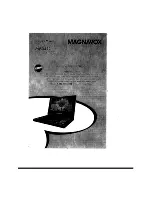
TI206 MPU-24
25
Section 7 – Performance Data
7.1 – Purpose
This section provides performance data for the TI206 MPU-24. Continual reference to this information
will enable the user to obtain maximum performance, utilization and service life from the MPU. Although
maximum performance is not always required, regular referral to this section is recommended for the
following reasons:
To generate knowledge of unit’s performance margins to enable the operator to make sound
A.
judgment when unexpected conditions or alternate operational requirements are encountered.
To enable the user to readily recognize situations requiring maximum performance.
B.
To gain experience in accurately estimating the effects of variables for which data is not presented.
C.
To help the operator determine if an aircraft system malfunction exists by comparing actual
D.
performance with expected performance.
!
The information provided in this section is primarily intended for operational
planning and is most useful when planning operations under unfamiliar
conditions or environmental extremes. The data may also be used to establish
local operating procedures and to ensure unit’s operational life is maximized.
NOTE
7.2 – General
The data presented covers the maximum range of conditions and performance that can reasonably be
expected. In each area of performance, the effects of temperature and dc electrical load demand relating to
the ground power support requirements are presented. Wherever practical, data is presented conservatively.
However, NO GENERAL CONSERVATISM HAS BEEN APPLIED. All performance data presented is within the
applicable limits of the MPU.
7.3 – Data Basis
The type of data used is indicated at the bottom of each performance chart under DATA BASIS. The
applicable report and date of the data are also given. The data provided generally are based on one of three
categories:
Derived From Actual Controlled Testing: Controlled test data obtained on a similar unit type.
A.
Calculated Data: Data based on tests, but not on a similar unit type placed under a controlled test.
B.
Estimated Data: Data based on estimates using rules of physics, mathematics, and electrical
C.
engineering principles and concepts, but not verified by tests.












































